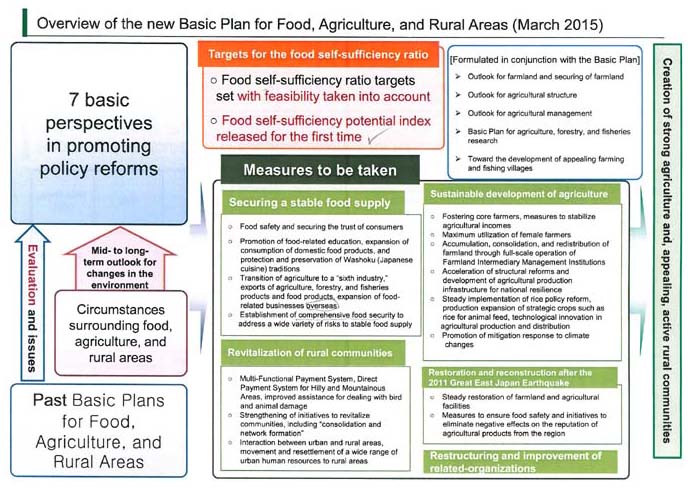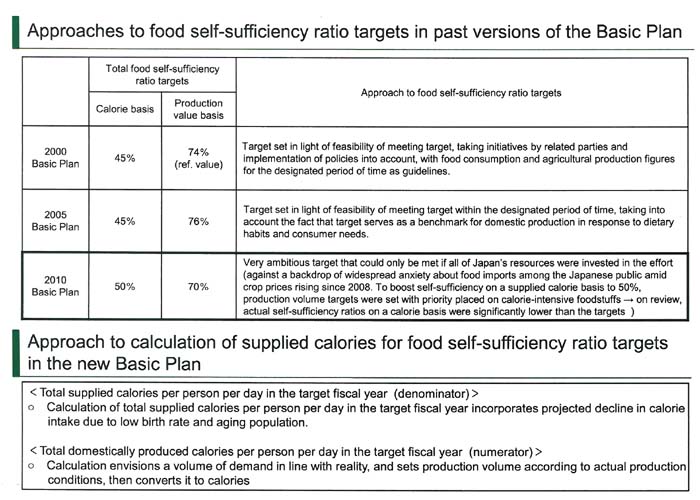Fumihiro Kabuta, Ph.D.
Professor, National Graduate Institute for Policy Studies (GRIPS), Japan
There is the process of reviewing and reassessing basic policies from a mid-term perspective, based on the Basic Law on Food, Agriculture, and Rural Areas, which entails reassessment and target modification of the Basic Plan for Food, Agriculture, and Rural Areas approximately every five years, taking changes in the circumstances surrounding food, agriculture, and rural areas, and the results of evaluations of policies’ effectiveness, into account. The newest (fourth) Basic Plan for Food, Agriculture, and Rural Areas was approved by a Cabinet decision in April of this year (2015). Policy review on securing stable food supply and food security at new basic plan will be outlined as follows:
I. Revision of targets for food self-sufficiency ratio
1. In the Basic Plans of 2000 and 2005, the target for food self-sufficiency ratio were set with a priority on the feasibility of meeting the target within the designated period of time, with food consumption and agricultural production figures as guidelines. Specifically, a production capacity target (production volume) for each food item was set based on production and consumption trends and the effectiveness of policies, and the production volumes converted to supplied calories and monetary amounts, based on which the target for food self-sufficiency ratio was set.
2. By contrast, the 2010 Basic Plan set a very ambitious target that could only be met if all of Japan’s resources were invested in the effort, against a backdrop of rising crop prices driven by increasing demand for agricultural products in emerging economies, and resulting in widespread anxiety about food imports among the Japanese people. To boost self-sufficiency on a supplied calorie basis to 50%, production volume targets were set with priority placed on calorie-intensive foodstuffs. Specifically, the plan called for expanding production of wheat, soybeans, etc., while on the consumption side it called for promoting rice consumption and limiting intake of oils and fats. The target on a production output basis was set at 70%, with production volume calculated at the prices of the base year (fiscal 2008).
3. However, in terms of the actual progress of meeting targets for food self-sufficiency ratio after the last Basic Plan was formulated, (1) on the production side, actual output of rice for flour, rice for livestock feed, wheat, soybeans, etc. was far below targets, (2) on the consumption side, the volume of consumption of foods where increased consumption was predicted, including rice and rice flour, was below what was envisioned, while conversely there was higher than predicted consumption of oils, fats, and other items which the Plan called for lowering. As a result the actual food and livestock feed self-sufficiency ratios on a supplied calorie basis were significantly lower than the targets. On a production output basis, performance was robust thanks to consumption in line with prediction of beef, pork and other foods that contribute greatly to the total monetary value of domestic production.
4. Based on a review of these targets and the degree to which they were met, the new Basic Plan adopts the same approach as those of 2000 and 2005, prioritizing the feasibility of meeting the target within the designated period of time, envisioning a volume of demand in line with reality, and setting production volume according to actual production conditions. With this approach, the 2025 target for food self-sufficiency ratio is set at 45% on a supplied calorie basis and 73% on a production output basis.



(To be continued)
|
Date submitted: Jan. 4, 2016
Reviewed, edited and uploaded: Jan. 4, 2016
|


New Basic Plan and Policy Review on Securing Stable Food Supply and Food Security in Japan (Part 1: Revision of targets for food self-sufficiency ratio)
Fumihiro Kabuta, Ph.D.
Professor, National Graduate Institute for Policy Studies (GRIPS), Japan
There is the process of reviewing and reassessing basic policies from a mid-term perspective, based on the Basic Law on Food, Agriculture, and Rural Areas, which entails reassessment and target modification of the Basic Plan for Food, Agriculture, and Rural Areas approximately every five years, taking changes in the circumstances surrounding food, agriculture, and rural areas, and the results of evaluations of policies’ effectiveness, into account. The newest (fourth) Basic Plan for Food, Agriculture, and Rural Areas was approved by a Cabinet decision in April of this year (2015). Policy review on securing stable food supply and food security at new basic plan will be outlined as follows:
I. Revision of targets for food self-sufficiency ratio
1. In the Basic Plans of 2000 and 2005, the target for food self-sufficiency ratio were set with a priority on the feasibility of meeting the target within the designated period of time, with food consumption and agricultural production figures as guidelines. Specifically, a production capacity target (production volume) for each food item was set based on production and consumption trends and the effectiveness of policies, and the production volumes converted to supplied calories and monetary amounts, based on which the target for food self-sufficiency ratio was set.
2. By contrast, the 2010 Basic Plan set a very ambitious target that could only be met if all of Japan’s resources were invested in the effort, against a backdrop of rising crop prices driven by increasing demand for agricultural products in emerging economies, and resulting in widespread anxiety about food imports among the Japanese people. To boost self-sufficiency on a supplied calorie basis to 50%, production volume targets were set with priority placed on calorie-intensive foodstuffs. Specifically, the plan called for expanding production of wheat, soybeans, etc., while on the consumption side it called for promoting rice consumption and limiting intake of oils and fats. The target on a production output basis was set at 70%, with production volume calculated at the prices of the base year (fiscal 2008).
3. However, in terms of the actual progress of meeting targets for food self-sufficiency ratio after the last Basic Plan was formulated, (1) on the production side, actual output of rice for flour, rice for livestock feed, wheat, soybeans, etc. was far below targets, (2) on the consumption side, the volume of consumption of foods where increased consumption was predicted, including rice and rice flour, was below what was envisioned, while conversely there was higher than predicted consumption of oils, fats, and other items which the Plan called for lowering. As a result the actual food and livestock feed self-sufficiency ratios on a supplied calorie basis were significantly lower than the targets. On a production output basis, performance was robust thanks to consumption in line with prediction of beef, pork and other foods that contribute greatly to the total monetary value of domestic production.
4. Based on a review of these targets and the degree to which they were met, the new Basic Plan adopts the same approach as those of 2000 and 2005, prioritizing the feasibility of meeting the target within the designated period of time, envisioning a volume of demand in line with reality, and setting production volume according to actual production conditions. With this approach, the 2025 target for food self-sufficiency ratio is set at 45% on a supplied calorie basis and 73% on a production output basis.
(To be continued)
Date submitted: Jan. 4, 2016
Reviewed, edited and uploaded: Jan. 4, 2016